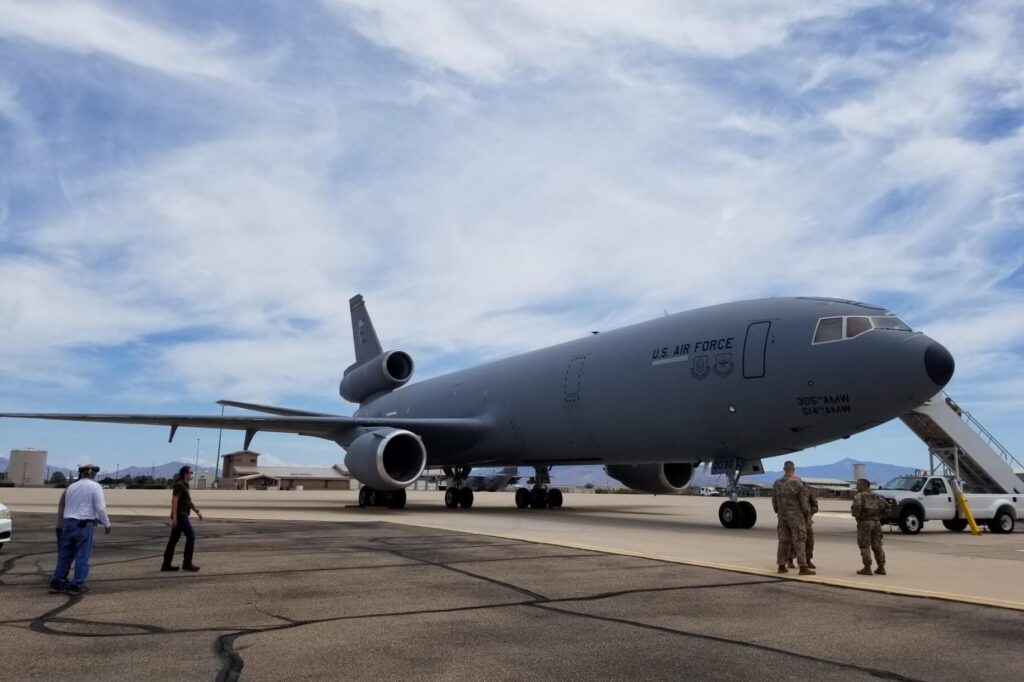A first McDonnell-Douglas KC-10A Extender was flown to the Davis Monthan storage facility in Arizona. The U.S. Air Force plans to withdraw its entire KC-10 fleet within the next five years, while the bumpy entry into service of the KC-46 Pegasus continues.
The aircraft, serial number 86-0036, belonged to the 305th Air Mobility Wing of McGuire AFB, New Jersey, and was a mere 32 years old (some of the KC-135 Stratotankers have hit the 60-year mark). It arrived at the 309th Aerospace Maintenance and Regeneration Group (AMARG), colloquially known as The Boneyard, on July 13, 2020. Two more Extenders will be sent to Arizona before the end of the year. From 2021, up to twelve aircraft will be retired per year.
The KC-10, as well as its smaller colleague the Boeing KC-135 Stratotanker, will be gradually replaced by the KC-46 Pegasus. The Extender was capable of carrying over 160 tonnes of fuel, 70 tonnes more than its replacement.
Based on the McDonnell-Douglas DC-10-30F freighter, the KC-10 entered service 40 years to the day before the first was retired, on July 12, 1980. 60 of the tri-jets were ordered for the United States Air Force, while two were sold to the Netherlands. While it is a well-democratized concept today with the Multi-Role Tanker Transport (MRTT), the KC-10 was the first aircraft to offer both substantial tanker and transporter capacities.
Difficult USAF tanker fleet replacement
The USAF is currently struggling with its aerial refueling capacities, both for its own needs and those of its allies. In January 2020, General Stephen R. Lyons, commander of U.S. Transportation Command, said the U.S. military was “exceeding the red line“. And to make matters worse, the replacement of the tanker fleet has been anything but smooth. After years of production delays, the KC-46 Pegasus holds three crucial deficiencies to its name.
Upon delivery of the first aircraft on January 10, 2019, more than a year after the due date, it came to light that the “Remote Vision System” (RVS), developed by Rockwell Collins, did not work as intended, especially under certain light conditions. The RVS is composed of several sensors and cameras that should help a boom operator during aerial refueling. But the USAF has discovered discrepancies between the motion shown by the RVS and what was happening in real life.
A new version, called RVS 2.0, was announced in April 2020. “With the help of scientists and engineers from both enterprises, the Air Force will lead design reviews and approve specifications to drive the partnership toward initial fielding in 2023,” the USAF announced.
Another problem was the design of the boom itself. During aerial refueling, both the tanker and the receiving aircraft must work together to connect the nozzle of the boom to the receptacle of the aircraft. However, multiple aircraft within the USAF, including the A-10 ground attack aircraft, were found unable to generate sufficient thrust to connect. Boeing was awarded $55.5 million by the USAF to fix it.
The latest issue upgraded to a Category I was the “excessive fuel leaks” that were discovered during a refueling test in July 2019. “In some cases with this issue, aircraft maintenance crews are finding fuel between the primary and secondary fuel protection barriers within the system,” Boeing reported. As per the contract, it is now up to the manufacturer to find a fix for this new problem – on its own funds.
Deliveries of the aircraft were suspended several times over quality concerns: twice in 2019 after loose tools were found in the tankers received by the USAF, including in the closed compartments of their wings, and once in 2020 after foreign object debris (FOD) was discovered in the fuel tanks.
In March 2020, General David Goldfein, Chief of Staff of the U.S. Air Force, told the Congress he would only send the KC-46A in a contested environment with highly trained crews if absolutely necessary. “We won’t use it for day-to-day operations, but it will be made available for a contingency,” Goldfein said.

